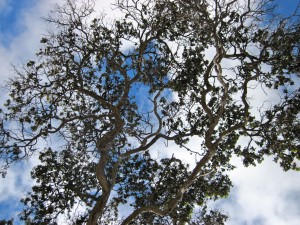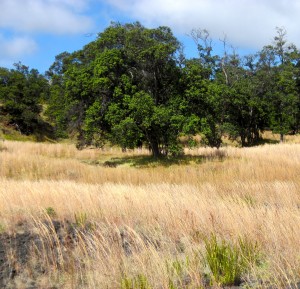By Mike McGee, Field Supervisor
 Around the year 1500, an old growth Ohia Lehua tree came crashing to the ground near the present day town of Volcano, HI. It made a thunderous crash although no one was there to witness it. It destroyed the undergrowth around it and killed many individual organisms that depended on the Ohia Lehua tree for their survival such as: epiphytes, various species of honey creeper nests, and endemic insects. The tree had been one of the first pioneers on what had been a barren black lava field. It had most likely lived to the ripe old age of about 400 years before it lost its battle with gravity and came crashing down to a violent end.
Around the year 1500, an old growth Ohia Lehua tree came crashing to the ground near the present day town of Volcano, HI. It made a thunderous crash although no one was there to witness it. It destroyed the undergrowth around it and killed many individual organisms that depended on the Ohia Lehua tree for their survival such as: epiphytes, various species of honey creeper nests, and endemic insects. The tree had been one of the first pioneers on what had been a barren black lava field. It had most likely lived to the ripe old age of about 400 years before it lost its battle with gravity and came crashing down to a violent end.
Now in its place, on a small native forest reserve, another tree holds a reminder, a vestige of its fore bearer. The tree is nearing the end of its run. A stately elder in a forest of rapid change. The tree has a hollow space under its trunk, where the previous tree has rotted away. The new tree has buttressed itself around the hole, and built solid, seamless roots that prop it up like concrete pillars under a beach pier.
Dynamic stability in ecology is the concept that dynamic and drastic changes in the system are the mechanism that provide its stability. The tree crashes, allowing for new growth. The fallen log provides a plateau for more trees to get above the forest floor. The new tree grows, crashes and the system repeats. This pattern is found everywhere in nature from raging forest fires to flooded deltas. This system reboot allows for sustainable growth instead of rapid succession. The healing aspect of the tree falling is that it further develops complexity and depth within the system. Various species, varying ages of those species, and the numerous needs  and opportunities provides the forest with diversity. The forest is only healthy due the traumas it has faced. And the traumas are only tolerable to a certain extent, an extent based on the strength of the forest.
and opportunities provides the forest with diversity. The forest is only healthy due the traumas it has faced. And the traumas are only tolerable to a certain extent, an extent based on the strength of the forest.
Humans often present themselves as separate from the natural world. We speak of what separates us from other organisms. Most of us spend more time in artificial indoor environments than we spend outside. The time we do spend outdoors is often in manicured parks and fields. Yet our brains our still hard-wired to be calmed by nature and our bodies respond better to clean, fresh air rather than filtered sterile air in buildings. Our behaviors and thoughts may have less to do with what separates us from the natural world than with what connects it.
When we look at human emotional growth, you can see the residues of our connections in ecological systems and the consequences of when we fail to adhere to the concepts of dynamic stability. When we are shielded from death and loss, the first one we experience is devastating. We, as humans, can see it as a personal attack rather than a necessary cycle of life. When we are supported too much, we come to depend on that structure for our support and meaning in our lives. When we grow without emotional support, or even worse, with a negative emotional attention we collapse outright or lose ourselves so much that few can recognize us, like a wind battered pine growing horizontally to the ground.
The key, for us, is grow like the old growth forest, slowly and surly and embrace the tragedy and loss around us. If we persist, we will find ourselves diverse in our coping skills and well-versed in the language of altruism. There is a time to mourn, as seedlings do not sprout overnight.
Ecological Concepts and Application on the Human Scale
By Mike McGee, Field Supervisor Around the year 1500, an old growth Ohia Lehua tree came crashing to the ground near the present day town of Volcano, HI. It made a thunderous crash although no one was there to witness it. It destroyed the undergrowth around it and killed many individual organisms that depended on …
By Mike McGee, Field Supervisor
Now in its place, on a small native forest reserve, another tree holds a reminder, a vestige of its fore bearer. The tree is nearing the end of its run. A stately elder in a forest of rapid change. The tree has a hollow space under its trunk, where the previous tree has rotted away. The new tree has buttressed itself around the hole, and built solid, seamless roots that prop it up like concrete pillars under a beach pier.
Dynamic stability in ecology is the concept that dynamic and drastic changes in the system are the mechanism that provide its stability. The tree crashes, allowing for new growth. The fallen log provides a plateau for more trees to get above the forest floor. The new tree grows, crashes and the system repeats. This pattern is found everywhere in nature from raging forest fires to flooded deltas. This system reboot allows for sustainable growth instead of rapid succession. The healing aspect of the tree falling is that it further develops complexity and depth within the system. Various species, varying ages of those species, and the numerous needs and opportunities provides the forest with diversity. The forest is only healthy due the traumas it has faced. And the traumas are only tolerable to a certain extent, an extent based on the strength of the forest.
and opportunities provides the forest with diversity. The forest is only healthy due the traumas it has faced. And the traumas are only tolerable to a certain extent, an extent based on the strength of the forest.
Humans often present themselves as separate from the natural world. We speak of what separates us from other organisms. Most of us spend more time in artificial indoor environments than we spend outside. The time we do spend outdoors is often in manicured parks and fields. Yet our brains our still hard-wired to be calmed by nature and our bodies respond better to clean, fresh air rather than filtered sterile air in buildings. Our behaviors and thoughts may have less to do with what separates us from the natural world than with what connects it.
When we look at human emotional growth, you can see the residues of our connections in ecological systems and the consequences of when we fail to adhere to the concepts of dynamic stability. When we are shielded from death and loss, the first one we experience is devastating. We, as humans, can see it as a personal attack rather than a necessary cycle of life. When we are supported too much, we come to depend on that structure for our support and meaning in our lives. When we grow without emotional support, or even worse, with a negative emotional attention we collapse outright or lose ourselves so much that few can recognize us, like a wind battered pine growing horizontally to the ground.
The key, for us, is grow like the old growth forest, slowly and surly and embrace the tragedy and loss around us. If we persist, we will find ourselves diverse in our coping skills and well-versed in the language of altruism. There is a time to mourn, as seedlings do not sprout overnight.